Vermont
Vermont’s Foster Care IT System Predates the Internet — And Puts Kids at Risk
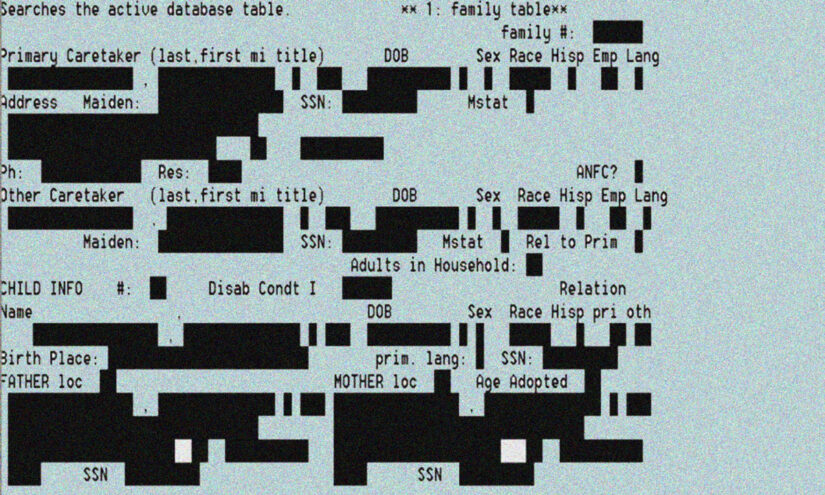
Support The 74’s year-end campaign. Make a tax-exempt donation now.
Erinn Rolland-Forkey has been a foster parent in Vermont for about 25 years, and has been active in that time advocating for the rights of parents and children in the system. In 2016, she was even appointed to sit on a foster parent workgroup created by the Legislature, which pushed, among other reforms, that the state provide a two-pager to foster parents each time a child was placed in their care.
But while Rolland-Forkey is glad to receive that document, which is supposed to guarantee she’ll get at least some basic information about the child in her care, she never assumes it’ll be accurate or complete.
As Rolland-Forkey was speaking to a VTDigger reporter over the phone, she began inspecting the state paperwork that had come with a child who had recently been in her home. Under “allergies and dietary restrictions,” she said, someone had simply drawn a line, suggesting there were none to report.
“Actually, that child has an EpiPen,” Rolland-Forkey said, “and was allergic to all shellfish.”
She learned about the allergy from the child, who mentioned it in conversation about a week after arriving.
Rolland-Forkey and many advocates — including Vermont’s newly created independent ombudsman for child welfare — say such scenarios are not rare, and the culprit, in most cases, is clear: antiquated information technology systems serving the family services division at the Department for Children and Families.
Vermont’s state government is no stranger to IT woes. Amidst a pandemic-induced economic shutdown, for example, the state’s unemployment system crashed repeatedly and later exposed the Social Security numbers of thousands of Vermonters.
But the problems with the family services divisions’ IT systems nevertheless stand out — not only because of the age of the databases, but because of the stakes involved.
The primary system, called SSMIS, for inputting and warehousing basic information about minors in state custody and their placements was created in the early 1980s. State officials and advocates alike note frequently that this means the cyber backbone of Vermont’s child protection system predates the creation of the World Wide Web. A secondary system, FSDNet, that handles child abuse reporting intake information and case notes, dates back to the 1990s.
Before becoming deputy advocate in Vermont’s new Office of the Child, Youth and Family Advocate, which has independent oversight powers over DCF, Lauren Higbee worked at the department for five years, and has firsthand experience with these data systems. She’s since developed a shorthand for conveying their limited functionality.
“It doesn’t even have the capability of using a mouse,” she said of SSMIS. “That’s how old it is.”
In her former role, Higbee oversaw residential licensing and special investigations at DCF. And she recalled how badly the system complicated her work.
“You can’t search by facility to see all the allegations attributed to one facility. Right? So I’m not getting the scope, the history, the issue of what happened, or has happened or allegedly happened in one facility,” she said. “Huge issue.”
SSMIS is so clunky that even the most basic information about a child can be hard to find. If they’re placed with a private service provider which may have several locations, for example, the system will only register that provider’s name — not the specific address where that particular child is located.
DCF Deputy Commissioner Aryka Radke, who helms the department’s family services division, argued that this doesn’t mean that the state doesn’t know the location of the children in its care. But she acknowledged that identifying where it has stored such information is sometimes difficult.
“The address could be in case notes, which means that it’s gonna be harder to find. Obviously, the worker has the address for the child, which means we need to contact the worker to get the information. Or the district director may have it. Or it’s in a paper file at the district office. Or it’s in the worker’s telephone,” she said. “So it’s not readily available sometimes, but it’s absolutely there.”
But for Matthew Bernstein, who leads Vermont’s Office of the Child, Youth and Family Advocate, information that’s hard to find is almost as bad as information that doesn’t exist — putting kids at risk.
“We don’t know what medications a kid is allergic to,” he said. “A kid is in the hospital having an acute event — and sure, medical providers can do their thing and sure, some DCF workers can shuffle around looking for some paper that says what medications the kid is allergic to or anything else relevant to that. But that information is not at our fingertips. And that can obviously be catastrophic.”
As work-arounds to these inadequate systems, state workers and administrators report that they rely on an unwieldy and rickety system of supplemental databases, their own memories, and more than 30 Excel spreadsheets. The result is redundant data entry which is time consuming and, most importantly, vulnerable to human error.
“When we remove a child and take them into state custody, we’re really taking responsibility for them and all that that entails,” said Amy Rose, the policy director for the nonprofit advocacy group Voices for Vermont’s Children. “And not prioritizing just even accurate information — or the ability to access that information — really sets us all up for mistakes. And those mistakes can have a significant impact on the lives of the children that we’re taking responsibility for.”
A report on the drivers behind the high rates of children in state custody in Vermont, produced by researchers at the University of Vermont two years ago, named the “immediate priority” of replacing the division’s IT infrastructure as its first recommendation.
The researchers found that data systems were inadequate and did not allow child welfare workers to “meaningfully measure and track child safety, permanency, or wellbeing.” Bad data impacted decision-making, and created “opportunities for individual bias in decisions to place a child,” the study’s authors wrote.
In November 2021, Sally Borden, the co-chair of Vermont’s citizen advisory council to DCF, urged lawmakers in testimony to invest in a new IT infrastructure and marveled that the system wasn’t riddled with even more errors. She argued that the status quo makes the foster care system a sort of black box. Because family services databases cannot reliably search, organize, and collate data, administrators and advocates alike often find it impossible to accurately measure a problem — let alone measure progress in fixing it.
To figure out how many parents involved with DCF were dealing with substance use disorders, she noted, the department had recently relied on a hand count, derived from asking individual family services workers to tally up their cases.
“This, in the middle of an opioid crisis, is absurd,” Borden wrote.
In October 2020, Christine Johnson, then the head of DCF’s family services division, offered a similar critique during a webinar hosted by Voices for Vermont’s Children. Johnson recalled arriving at her job the year prior and, in an attempt to get a lay of the land, requested a variety of data points she believed would be available “with a few strokes” in a user-friendly dashboard.
“What I found very quickly was that we had a system that was built in 1982 — back when computers weren’t even really a thing,” she said.
Radke, Johnson’s successor, pushed back at the notion that the state’s IT system puts children at any risk. “I think it impacts my team and that they have to go the extra mile to make sure that we have the level of care that we need,” she said.
Nevertheless, she stressed that an upgrade was of utmost importance. And Radke has made more progress than any of her predecessors to fix the problem, although it is only a start: She is finalizing a request for proposals to build a new IT system, expected out this January.
But once contractors submit their offers, the state will have to decide whether it is willing to pay for an overhaul. No one knows yet what the price tag will be.
“At this point, based on our estimates of similarly situated states, we’re estimating that the cost could be anywhere between $35 and $40 million,” Radke said. “But of course we’ll have a much better idea when we get those responses.”
Luckily, the federal government will likely pay half the cost. And those pushing for a new system can also plausibly argue the upfront cost will pay for itself over time. The state leaves federal dollars on the table each year in reimbursable expenses because the data system regularly fails to comply with federal reporting requirements.
But even if the state fully commits to funding a new system, it’ll be years before a new one is in place. Radke guessed three — at a minimum.
In the meantime, state workers and families will have to keep making do.
Rolland-Forkey, the veteran foster parent, wonders whether that’s tenable — for her, for other foster parents, and particularly for the children they bring into their homes. She worries the system causes even more “fracturing” for children already dealing with such instability. And she struggles with a feeling of “moral injury,” when she realizes a kid in her care isn’t taking the medications they need, or missed a doctor’s appointment, court hearing, or after-school activity because there was no reliable record available for her to consult.
“We’re supposed to be doing no harm,” she said. “We don’t take an oath or anything, but I feel that. I feel like that’s what we should be.”
This story was originally published in VTDigger.
Support The 74’s year-end campaign. Make a tax-exempt donation now.

Vermont
Obituary: Kaleb Bates-Wolcott, 1982-2024

This
obituary is written in honor of Kaleb’s life and memory.
Kaleb
Asher Bates-Wolcott was born at home in Elmore, Vt., on June 17.
1982. He died peacefully in the early morning on April 18, 2024, at
Central Vermont Medical Center in Barre, Vt., at the age of 41. He
had bravely, as the warrior he was, coped with muscular dystrophy
throughout his lifetime. Kaleb was an amazing human being. He was
strong-willed, intelligent, kind and generous, with a great sense of
humor — a good listener who patiently listened to the worried well
at his bedside.
Kaleb
lost his ability to walk at age 12 and creatively and fiercely
adapted to his life in an electric wheelchair. His top priority was
his social life. In Wauwatosa, Wis., he learned early that to meet
people he had to reach out to them, first by ignoring their fears and
biases of the disabled, and then disarming them with his wit and
humor. He quickly got a paper route with a friend who rode on the
back of his chair at top speed, while pitching papers onto lawns. In
high school, he began to watch cooking shows with a friend after
school, which developed into 15-20 teens regularly testing new
recipes in the kitchen into the early hours of the morning. Kaleb
prided himself on directing and inspiring his friends on how to
appreciate and cook good food. (His mother bought the groceries.
“Really, you NEED Chilean sea bass?”) Kaleb also had an eclectic
taste in music, ranging from Frank Sinatra to Wu-Tang Clan, obscure
local hip-hop to Coldplay and classical to jazz. While attending
Marquette University and the University of Wisconsin, he began, on
his own, to investigate the music scene in Milwaukee. Security guards
at each venue soon realized he wasn’t safe in the raucous crowds,
so he watched from backstage and met many famous musicians along the
way.
He
took in the world through conversations, food, art, music and film.
These hours of study resulted in critical and categorical knowledge
of just about everything, including the existence of bigfoot and
ancient aliens. He entertained all ages at his bedside by figuring
out what people’s tastes were and introducing them all to new
movies or the latest series or video game. Kaleb was supported, loved
and cared for by a large group of extended family, friends and
caregivers whom he cared for deeply.
Kaleb’s
immediate family members include his parents, James G. Wolcott, of
Jeffersonville, Vt., and Barbara A. Bates, of Westmoreland, N.H.; his
siblings, Eliza Bates-Wolcott, of Fayston, Vt., and Ezra Bates
-Wolcott, of Traverse City, Mich.; his nephews, Elijah Wolcott, of
Descanso, Calif., and Jackson Craig, of Fayston, Vt.; his niece,
Lilliana Hoy, of Sandy, Utah, and his maternal grandmother, Janet
Mckallor Beck, of Westmoreland, N.H.
A
Viking celebration of life will be held at a later date, with close
friends and family.
In
memory of Kaleb, consider donating to the charity of your choice.
“Pay it forward!”
He
would like that.
Vermont
The Best Small Towns in Vermont for a Weekend Retreat

Vermont could easily be considered one of the most beautiful states in America. Known for its European-inspired small-town charm, Vermont has no shortage of stunning historical buildings, adorable bed and breakfasts, and museums perfect for learning something new. Vermont is also famous for its maple syrup, which can be found at the various sugar houses. Make sure to pick up a bottle or try some syrup-based treats like lollypops and chocolate. Driving through Vermont is a treat on its own, full of iconic covered bridges, rolling hills, and breathtaking fall foliage. A fantastic weekend getaway destination, especially if you’re in the neighboring states of New York or New Hampshire or even across the border in Canada, you’ll surely find something the whole family will enjoy.
Montpelier
The capital of Vermont, Montpelier, is located off Interstate 89 and resides on the Winooski River. Come for the historic downtown and stay for the endless trails and sugar farms nearby. Visit the Lost Nation Theater and catch some live poetry, choir, or a play. At the Vermont State House, take a guided tour and dive into the state’s deep history. On the first Friday of alternating months, catch the Montpelier Art Walk, featuring local artists and vendors.
For those who want to embrace nature, walk the trails at the North Brand Nature Center, or explore nearby Hubbard Park with its 54-foot stone tower. Get the true Vermont experience and head to a sugar house. You can choose from either Bragg Farm or Morse Farm, where you can try various maple-based treats. Back in town, dine along the river and get some shopping in at a bookstore, or pick something up at the Barr Hill Distillery. Want to bring home some fresh produce? Anderbell Acres offers fresh fruit as well as a beautiful array of flowers. When it’s time to call it a night, rest comfortably at the Inn at Montpelier, a downtown boutique hotel with 19 rooms, all in a Victorian style.
Burlington
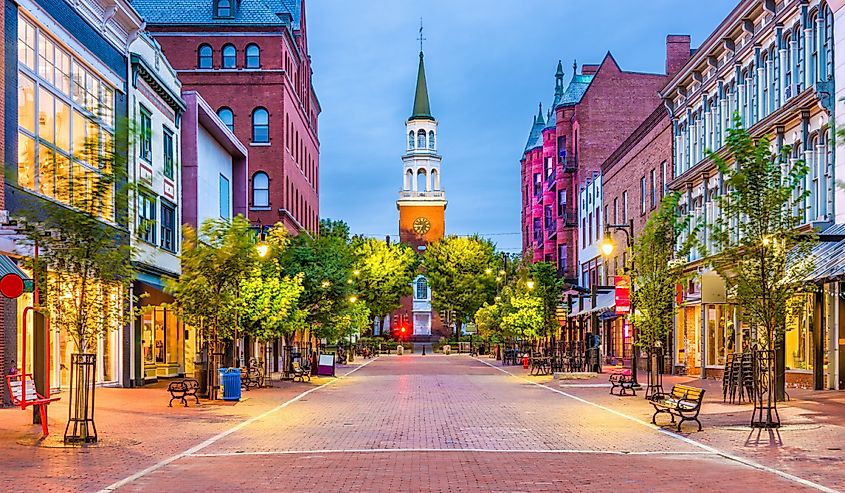
Located on Lake Champlain, which separates it from the state of New York, Burlington is a quaint waterfront town with all the charm. Enjoy a delicious meal and a one-of-a-kind experience on the Champlain Valley Dinner Train, and afterward take a romantic hot air balloon ride. For dessert, indulge in some iconic Ben and Jerry’s ice cream. Rest up at the Lang House on Main Street bed and breakfast. A converted 19th-century Victorian home, it also has onsite liquor sales of unique, local beverages. In the morning, grab a coffee at a coffeehouse, and browse the shops, including jewelry stores, glass-blowing studios, pottery boutiques, collectible shops, record stores, and vintage clothing storefronts.
Also make sure to stop in at Tinkering Turtle, an adorable toy shop perfect for younger travelers or those looking for a gift to bring back home. Spend your afternoon at Adam’s Apple Orchard, or at Shelburne Sugar Works, which specializes in maple syrup-based products. In the evening, hit the town and try something new at a brewery, a pub, a nearby vineyard, or even a tiki bar. If you’re visiting in the summer, go sailing on Lake Champlain, or take a trolley tour. You can also explore the trails of Camels Hump State Park, or take in the views at Oakledge Park. Visiting in the winter? There’s no shortage of ski trails. Choose from either the Bolton Valley, Jay Peak, or Smugglers Notch ski hills.
Stowe
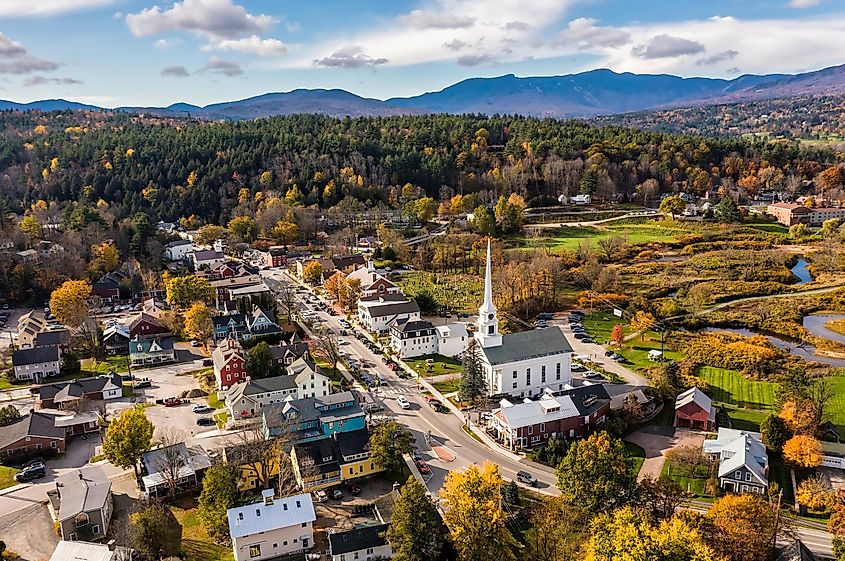
A lovely mountain town, Stowe is also right next to the Stowe Mountain Resort, which has over 116 ski trails, a summer gondola, indoor rock climbing, and ice skating in the winter. Nearby is the Arbortrek Canopy Adventure Park, which has ziplines and an obstacle course. Want even more of a rush? Book an Air Stowe helicopter tour. In the fall, get lost in the Percy Farm Corn Maze. In the summer, visit the Stowe Golf Park, a mini golf course perfect for both adults and kids.
For travelers over 21, take a brewery tour or try some local drinks at Stowe Cider. When it comes time for dinner, you have plenty of options, including flatbread pizza joints, steakhouses, delis, creperies, and artisanal bagel cafes. For those who love to shop, check out a bookstore, a natural body care shop, a toy store, or pick up some maple syrup to bring home. There are also plenty of options for outdoor gear if you plan to spend your trip exploring the many trails and parks surrounding the town. When it’s time to get some rest, check in at the Trapp Family Lodge, located right in town. It is home to four restaurants, a spa, as well as amenities like disc golf, tennis, and a swimming pool. You’ll also love the Austrian-inspired decor and architecture.
Woodstock
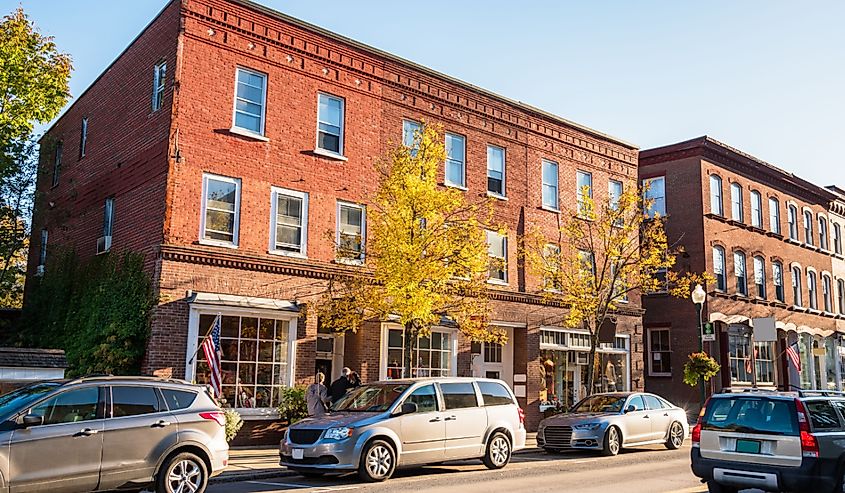
Right on the Ottauquechee River, Woodstock covers all the Vermont getaway checkboxes. Visit the Billings Farm and Museum, which has farm animals you can snap some pictures with and pet, as well as an onsite garden, and homemade cheese shop. For even more treats, head to Sugarbush Farm, which also makes cheese as well as maple syrup goodies. The area surrounding Woodstock is perfect for many outdoor activities, including mountain biking on forest trails, horseback riding through the trees on guided tours, and fishing on the river or at a nearby pond.
If you’re exploring town, stop in at the Yankee Bookshop, featuring local writers as well as worldwide bestsellers. Grab a latte at a cafe and enjoy the boutiques, fantasy stores, and galleries. In August, attend the Taste of Woodstock festival, which brings together the town’s restaurants. In September, take part in the Woodstock Art Festival and meet local artists, shop the vendors, and watch some live art creation take place. Looking for somewhere to lay your head? Check out the Woodstock Inn and Resort, a New England-style accommodation with four restaurants including a tavern, grill, and pour house. It also has a gift shop, spa, pool, and complimentary rental bikes. You can also take advantage of their falconry display, and observe a real falcon as well as its handler and learn about the magnificent bird.
Newport
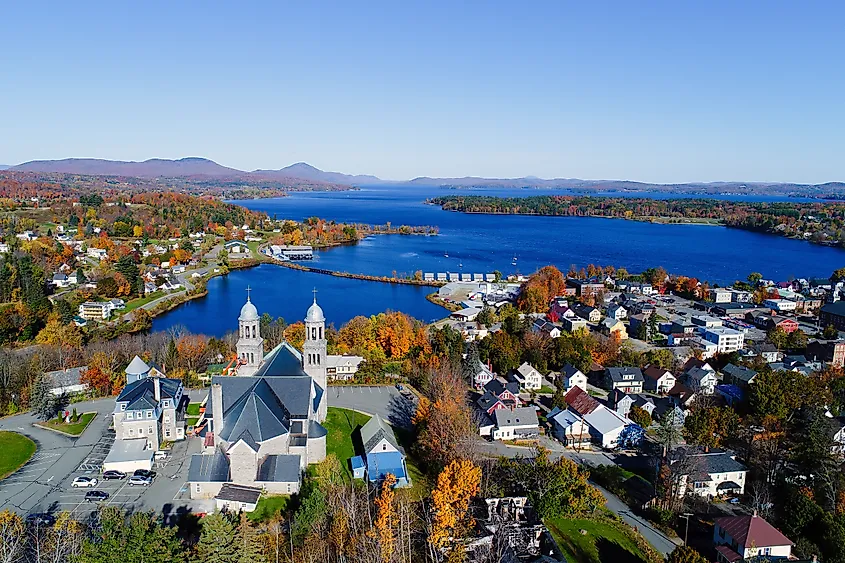
Just off Interstate 91, Newport is also right near the border into Canada, and a short drive to the province of Quebec and the beautiful French Canadian city of Montreal. It lies on the shores of Lake Memphemagog, which offers fishing, swimming, and plenty of park space for picnics. You can also book a cruise on the Northern Star, which offers shoreline sightseeing cruises as well as Sunday brunch sailings. The town offers both bike and kayak rentals, which make exploring the water as well as the surrounding trails a breeze. You also have the option of staying at the Prouty Beach and Campground, which has disc golf, tennis, basketball courts, and lake access.
In the town of Newport, stop by the farmers market and stock up on some fresh produce as well as sample local vendors. Or browse the shelves at the Newport Natural Market and Cafe. On the streets of downtown, find your next favorite read at Nevermore Bookstore, or pick out a great outfit at Rad Rags Boutique. Catch a movie at City Cinema, and after, try something delicious at Eden Speciality Ciders. Hungry? Newport has a handful of dining options, including Italian, Thai, and classic pub fare.
Brattleboro
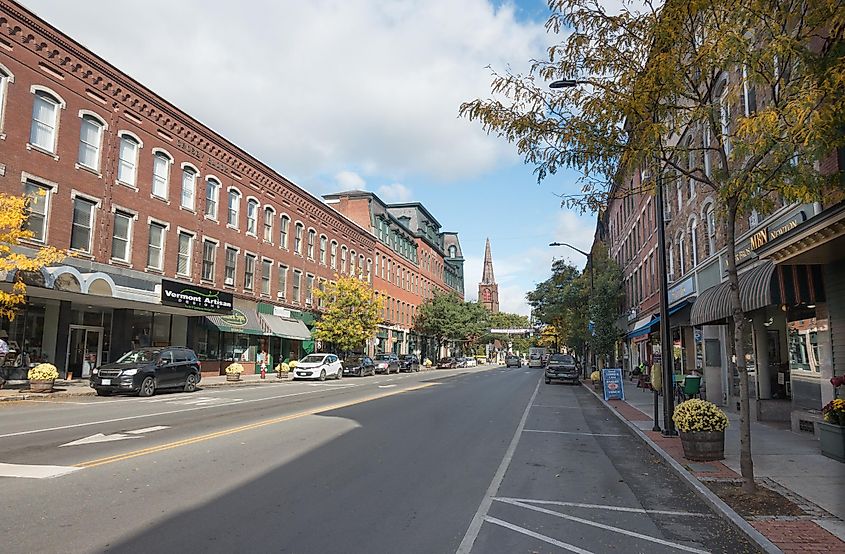
Next to the New Hampshire border, only separated by the Connecticut River, Brattleboro offers something for everybody. At Retreat Farm, enjoy the trails, as well as the petting zoo, forest playgrounds, and its adorable storybook-themed paths. In the nearby Fort Drummer State Park, take part in some hiking or mountain biking, as well as learn about the park’s revolutionary history. Afterward, make sure to travel through the covered bridges, a Vermont staple. When you make it back into town, park the car and walk the streets of downtown, stopping in at the bead stores, bookshops, thrift stores, and botanical shops.
For dinner, choose from options like Italian bistros and fish and chips restaurants, and for dessert, pick up a delicious pastry from a bakery. Want to keep the night going? Stop in at the Hermit Thrush Brewery, or at the Whetstone Beer Co. You can also catch a show at the Latchis Theater, whether it be a Hollywood recent release, an art film, or a live performance. Depending on when you visit, you can also take part in events such as the Valentine’s Day Bratt Luv Crawl, as well as the Brattleboro Film Festival and the Brattleboro Literacy Festival. Looking for the perfect hotel? Consider the Inn on Putney Road, a French Baronial bed and breakfast right near downtown.
Grafton
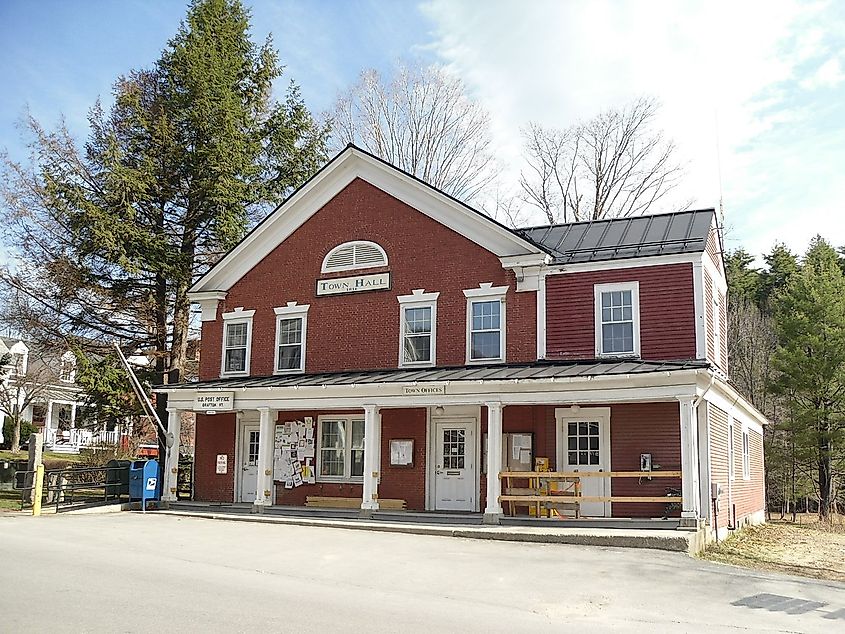
Located on the Saxtons River, Grafton is an adorable little farm town perfect for a relaxing getaway. Stay at the Grafton Inn, which has a unique Barn Pub, as well as the 1801 Tavern perfect for a late-night drink. It also has a daily breakfast and a seasonal swimming pond. Although small, Grafton has everything you need, including the Grafton Village Store. You can find local goods, a deli, a restaurant, and fantastic to-go picnic baskets here. Once you’ve purchased a basket, head to the Grafton Trails and Outdoor Center for some exploring, or to the Hamilton Falls hiking area.
The town also has the Grafton Village Cheese Company, where you can purchase some delicious cheeses and watch how they’re made. Nearby is Mercantile, which sells local handmade goods. Near Grafton is Plummers Sugarhouse, which has a gift shop with dozens of maple-based treats, as well as tours of the facility. For those who love history, stop at the Grafton Historical Society, and learn about the town and the state’s history, or get to know the local plants and other living things at the Nature Museum.
Chester
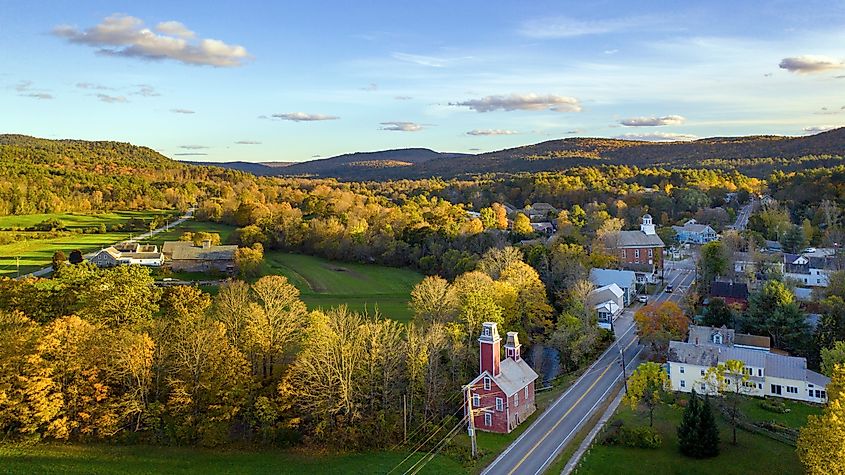
The town of Chester is near the border between Vermont and New Hampshire and is surrounded by lush forests, rolling hills, and the William’s River. Explore the trails of the Okemo State Forest, and while you’re there, spend the day at the Okemo Mountain Resort, which offers skiing in the winter, and mountain biking opportunities in the summer. The Chester Town Forest is also right next to town, providing even more ways to stretch your legs and perhaps even bring along a picnic. Sites to see around Chester also include Sunshine Acres, a beautiful and colorful nursery, and Leaning Ladder Farm, which offers gluten-free products. Make sure to also stop in at Mitch’s Maples Sugar House and stock up on some maple syrup goodies. If you’re looking to gather some fresh produce, baked goods, and other homemade finds, the Stone Village Farmer’s Market has just what you’re looking for.
In town, spend the afternoon at Pinnacle Park, which has a swimming pool, tennis courts, a disc golf course, and skating in the winter. As for shopping, check out an antique store, a quilting shop, a pottery studio, or a natural foods grocery store. And when you want to rest, sit down to some tea at the tearoom in the Rose Arbour. Chester is also full of history, which can be viewed at one of the historic buildings still standing in tow, including the old firehouse and train station. When it’s time for dinner, choose from options like Country Girl Diner or MacLaomainn’s Scottish Pub, and for dessert, check out the Southern Pie Cafe. For accommodations, the Inn Victoria is a bed and breakfast located right downtown.
Middlebury
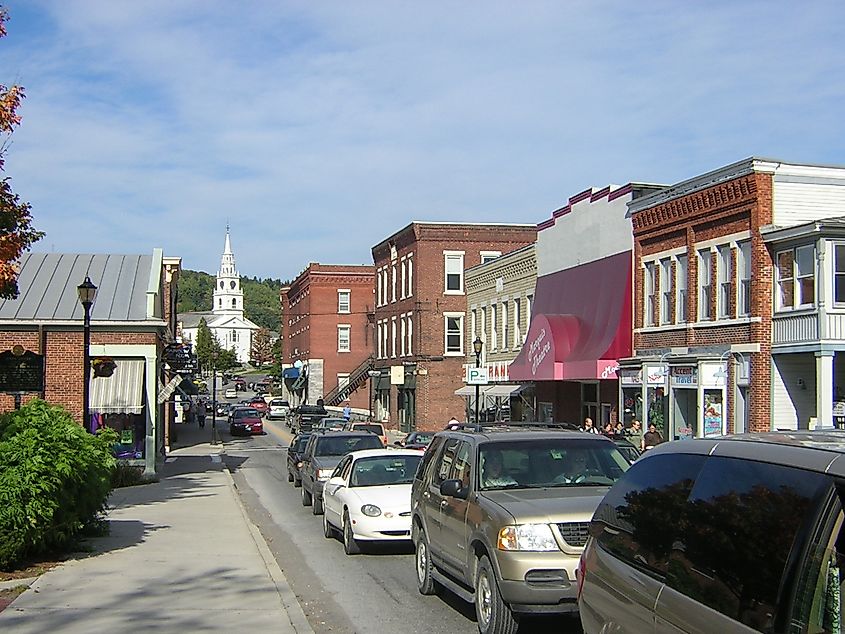
Situated on Otter Creek, Middlebury is close to the border between Vermont and New York, and not far from Burlington. It is covered in lush greenery, and lined with historic buildings. It also has a series of paths that circle the town, making getting around by foot or bike easy. Stop in at nearby Lake Dunmore for some swimming and fishing, or play a game of golf at the Ralph Myhre Golf Course. Middlebury was also home to the famous poet Robert Frost, and you can explore the interpretive trail dedicated to him, which features his poems throughout. Looking for more ways to explore? Check out the Happy Valley Orchard, which lets you pick your own apples in September and October.
For the adults, the Woodchuck Cider Mill and Golden Rule Mead both offer delicious, local beverages. In town, shop for fruits, veggies, crafts, and pastries at the farmers market. The main streets also have quaint shopping options, including jewelry stores, florists, leatherwork studios, antique stores, candy shops, and stationery stores. When it comes to meals, breakfast, lunch, and dinner are covered. In the morning, pick something up from a juicery or cafe. In the afternoon, stop by a sandwich shop and grab something to go. In the evening, enjoy some classic pub fare. When the sun starts to set, retire to the Middlebury Inn, located right downtown. It also has an onsite bar, Morgan’s Tavern, for those who want to keep the night going and perhaps meet some other travelers.
Whichever season you decide to venture into Vermont, know that activities and sights are abundant. Whether you’re into skiing and taking in the views, mountain biking in the summer months, or snapping some pics of the leaves as they change color in the fall, Vermont is a charming paradise where anyone can relax. Escape the hustle and bustle of day-to-day life, and book that much-needed weekend retreat.
Vermont
Lawmakers send to Gov. Scott bill to curb insurance companies’ influence on health care

Vermont legislators passed a bill to streamline insurance requirements for health care and are urging Gov. Phil Scott to sign the bill into law.
The bill, H.766, will reduce administrative delays and remove barriers to care for Vermont patients, according to proponents. The University of Vermont Health Care Network, the state’s largest health care provider, has been pushing for the bill’s passage.
“We have reached a point where insurance companies can tell us what we can and can’t do, even in life-threatening emergencies, and the victims are always patients,” Dr. Katie Marvin, a family physician at Lamoille Health Partners, said in a statement.
Marvin took particular aim at the insurance company practice of requiring prior authorization for drugs and procedures, putting clinicians in the position of having to ask permission from insurance companies before a patient can receive services.
“(Prior authorizations) lead to delays in care, lapses in medications and apathy in providers,” Marvin said. “This bill may change this, which is why I have supported H.766 through the legislative process and spoke to the Governor about it last week.”
Pediatrician: Insurance practices leading to a crisis for kids with asthma
The House passed the bill unanimously on March 13, while the Senate voted 25-2 in favor of the bill on April 26. The Senate added an amendment, approved by the House, which requires insurance companies to give patients access to at least one type of available asthma inhaler without prior authorization.
“Insurance practices are leading to a crisis in caring for kids with asthma right now,” Dr. Kristen Connolly, a pediatrician, said in a statement. “We have had to order multiple types of inhalers to supplement for the one type of inhaler patients actually need. We have heard of rationing and increases in ER visits. This is our health system now − here in Vermont. We can do better.”
More: Vermont health care providers blame prior authorization for compromising patient care
The bill also ends a process where insurance companies could request patient records before paying for health care services that had been delivered.
“The increase in administrative burden required increasing our staffing to process the claims,” Dr. Julie Lin, an independent dermatologist in St. Albans, said in a statement. “There were also times that this policy meant we asked patients if they were willing to come back on two different days for certain services we could have delivered in one appointment so we could get timely payment by the insurance company. This added delays in care and inconvenience for patients. We know how long patients are waiting for dermatology services and this only made it worse.”
Legislators don’t buy insurance companies’ argument that costs will increase due to the bill
Rep. Alyssa Black, D-Essex, rejected the argument insurance companies have been making against the bill that it will drive up costs.
“Payers claim H.766 will lead to increased costs, but prior authorizations are almost always approved, serving only to delay care, and can drive up costs through incentivizing people to go to emergency departments when care is not approved, which is the most expensive location,” Black said in a statement. “Primary care spends less, orders fewer tests, fewer unnecessary labs, and provides the most economic, best bang for your buck.”
Sen. Ginny Lyons, D-Chittenden Southeast, said the bill is a first step in decreasing the administrative burdens on practitioners.
“We all benefit when health care providers can get back to caring for patients, not paperwork,” Lyons said in a statement.
Contact Dan D’Ambrosio at 660-1841 or ddambrosi@gannett.com. Follow him on X @DanDambrosioVT.
-

 News1 week ago
News1 week agoLarry Webb’s deathbed confession solves 2000 cold case murder of Susan and Natasha Carter, 10, whose remains were found hours after he died
-

 News1 week ago
News1 week agoFirst cargo ship passes through new channel since Baltimore bridge collapse
-

 World1 week ago
World1 week agoHaiti Prime Minister Ariel Henry resigns, transitional council takes power
-

 World1 week ago
World1 week agoSpanish PM Pedro Sanchez suspends public duties to 'reflect'
-

 World1 week ago
World1 week agoUS secretly sent long-range ATACMS weapons to Ukraine
-

 News1 week ago
News1 week agoAmerican Airlines passenger alleges discrimination over use of first-class restroom
-

 Education1 week ago
Education1 week agoVideo: Johnson Condemns Pro-Palestinian Protests at Columbia University
-

 Movie Reviews1 week ago
Movie Reviews1 week agoAbigail Movie Review: When pirouettes turn perilous


















